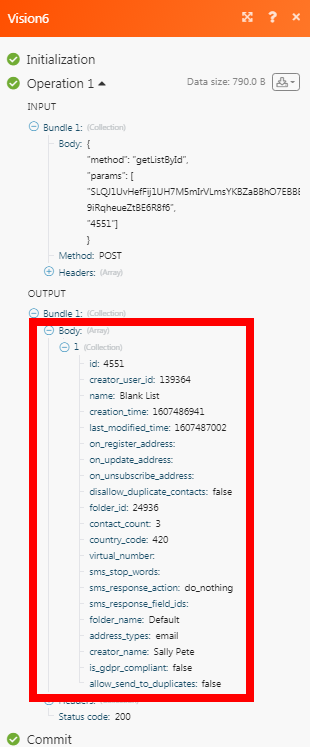- Vision6
- Getting Started with Vision6
- Connecting Vision6 to Boost.space Integrator
- Contacts
- Watch Added Contacts
- Watch Updated Contacts
- Watch Deactivated Contacts
- Watch Unsubscribed Contacts
- Watch Subscribed Contacts
- Watch Reactivated Contacts
- Search Contacts
- Get a Contact
- Create a Contact
- Subscribe a Contact
- Unsubscribe a Contact
- Reactivate a Contact
- Deactivate a Contact
- Update a Contact
- Delete a Contact
- Other
| Active with remarks |
|---|
| This application needs additional settings. Please follow the documentation below to create your own connectionUnique, active service acces point to a network. There are different types of connections (API key, Oauth…). More. |
The Vision6 modulesThe module is an application or tool within the Boost.space system. The entire system is built on this concept of modularity. (module - Contacts) More allow you to watch, create, update, retrieve, delete, subscribe, unsubscribe the contacts in your Vision6 account.
Prerequisites
-
A Vision6 account
In order to use Vision6 with Boost.spaceCentralization and synchronization platform, where you can organize and manage your data. More IntegratorPart of the Boost.space system, where you can create your connections and automate your processes. More, it is necessary to have a Vision6 account. If you do not have one, you can create a Vision6 account at vision6.com/signup.
To connect your Vision6 account to Boost.space Integrator you need to obtain the API Endpoint and API Key from your Vision6 account and insert it in the Create a connection dialog in the Boost.space Integrator moduleThe module is an application or tool within the Boost.space system. The entire system is built on this concept of modularity. (module - Contacts) More.
1. Log in to your Vision6 account.
2. Click Integrations > API Keys > Create a new API Key.
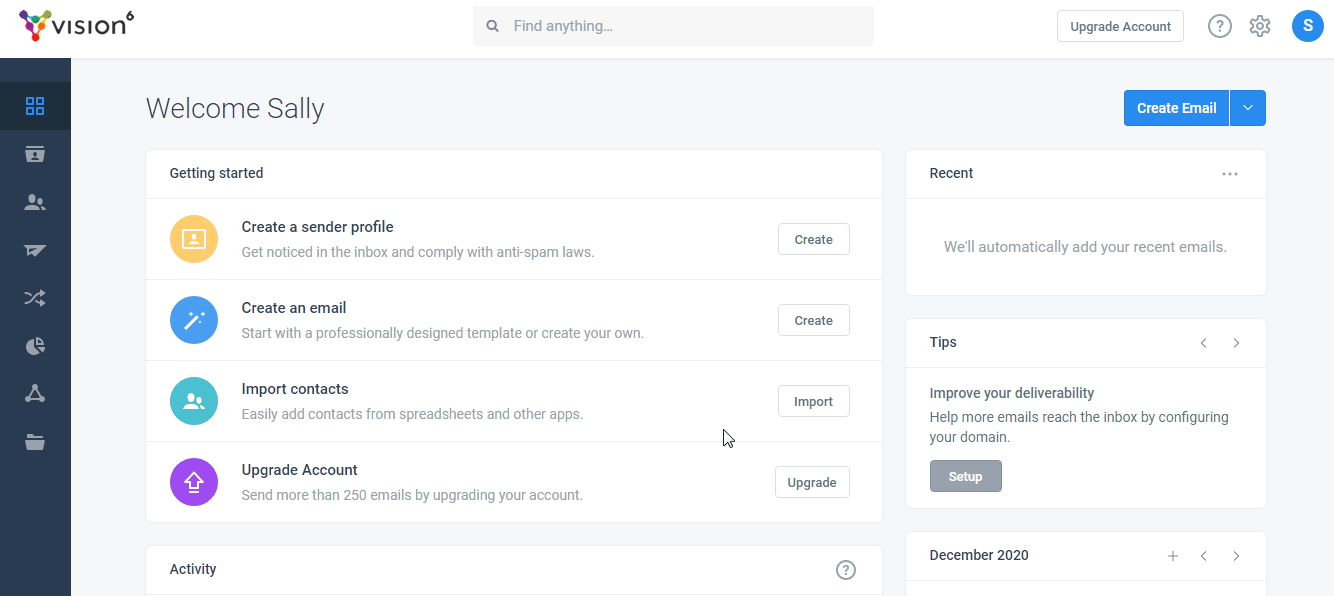
3. Enter the details and click Save.
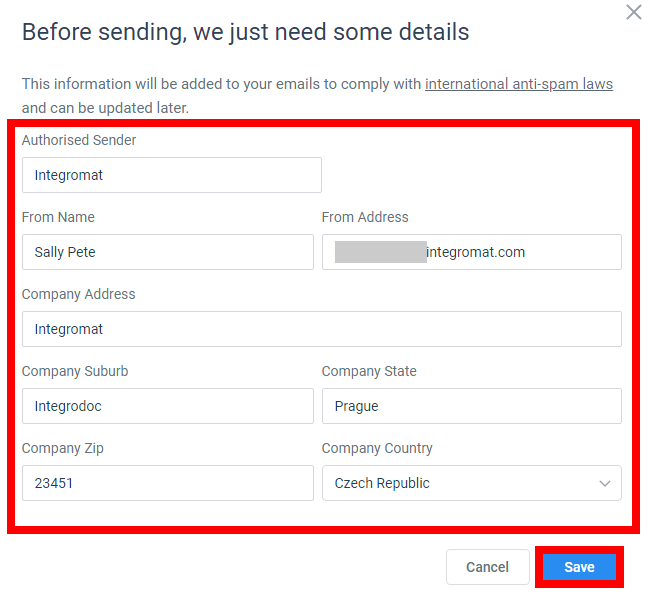
4. Click Create API Key, enter a name for the key, and select the permissions. Click Create API Key.
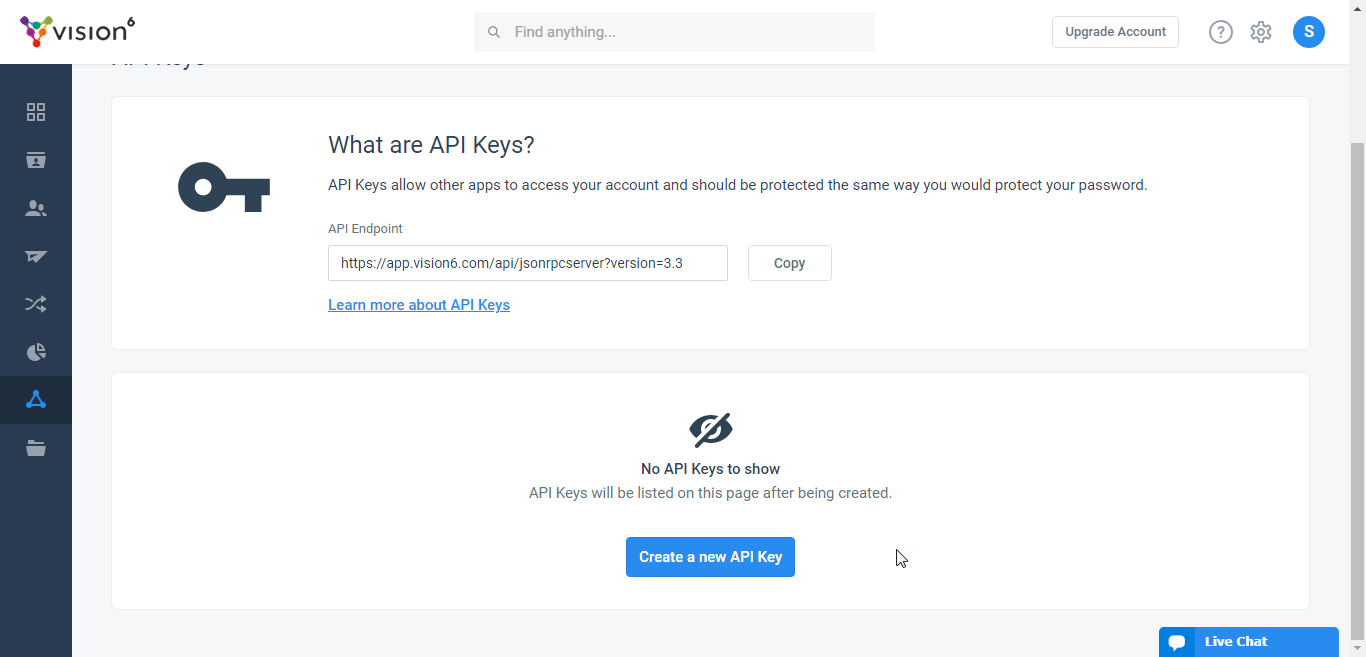
5. Copy the API Key to a safe place.
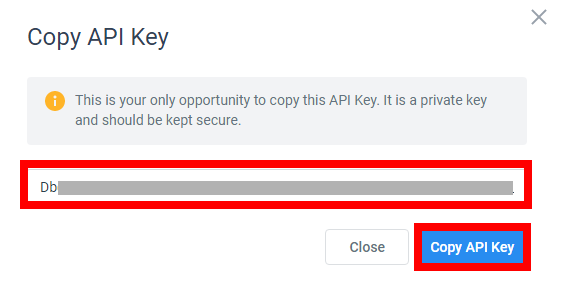
6. On the same API Keys page, copy the API Endpoint to a safe place.

7. Go to Boost.space Integrator and open the Vision6 module’s Create a connection dialog.
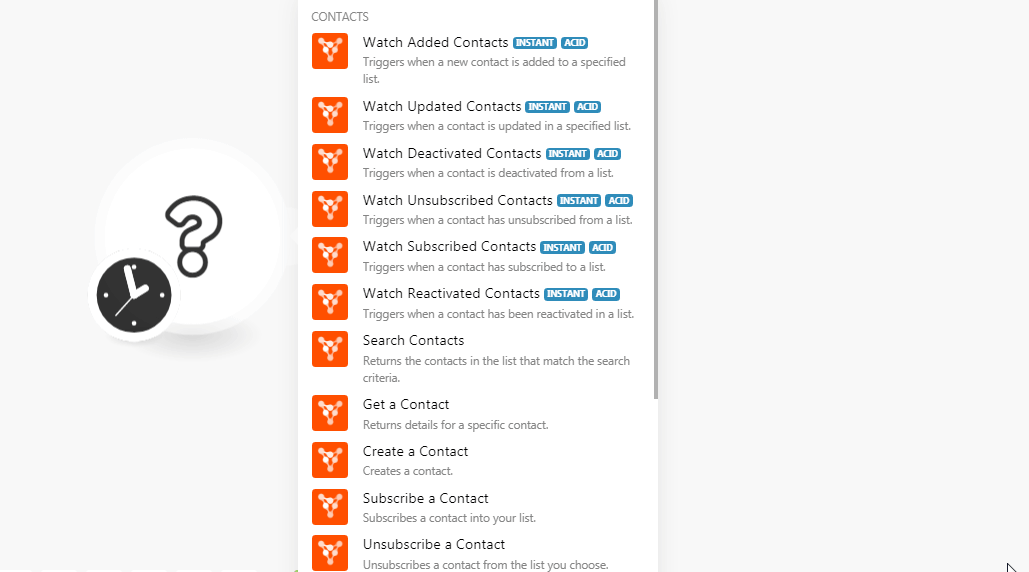
8. In the Connection name field, enter a name for the connection.
9. In the API Endpoint field, enter the endpoint URL address copied in step 6.
10. In the API Key field, enter the API key copied in step 5 and click Continue.
The connection has been established.
You do not have to add the webhooksA webhook is a way for an app to send real-time information to a specific URL in response to certain events or triggers. in the Vision6 as it is automatically done for you once you add and save an instant triggerEvery scenario has a trigger, an event that starts your scenario. A scenario must have a trigger. There can only be one trigger for each scenario. When you create a new scenario, the first module you choose is your trigger for that scenario. Create a trigger by clicking on the empty module of a newly created scenario or moving the... module to your scenarioA specific connection between applications in which data can be transferred. Two types of scenarios: active/inactive. More.
TriggersEvery scenario has a trigger, an event that starts your scenario. A scenario must have a trigger. There can only be one trigger for each scenario. When you create a new scenario, the first module you choose is your trigger for that scenario. Create a trigger by clicking on the empty module of a newly created scenario or moving the... when a new contact is added to a specified ID.
|
WebhookA webhook is a way for an app to send real-time information to a specific URL in response to certain events or triggers. Name |
Enter a name for the webhook. |
|
Connection |
|
|
List ID |
Select the List ID whose added contacts you want to watch. |
Triggers when a contact is updated in a specified list.
|
Webhook Name |
Enter a name for the webhook. |
|
Connection |
|
|
List ID |
Select the List ID whose updated contacts you want to watch. |
Triggers when a contact is deactivated from a list.
|
Webhook Name |
Enter a name for the webhook. |
|
Connection |
|
|
List ID |
Select the List ID whose deactivated contacts you want to watch. |
Triggers when a contact is unsubscribed from a list.
|
Webhook Name |
Enter a name for the webhook. |
|
Connection |
|
|
List ID |
Select the List ID whose unsubscribed contacts you want to watch. |
Triggers when a contact is subscribed from a list.
|
Webhook Name |
Enter a name for the webhook. |
|
Connection |
|
|
List ID |
Select the List ID whose subscribed contacts you want to watch. |
Triggers when a contact has been reactivated from a list.
|
Webhook Name |
Enter a name for the webhook. |
|
Connection |
|
|
List ID |
Select the List ID whose reactivated contacts you want to watch. |
Returns the contacts in the list that match the search criteria.
|
Connection |
|
|
List ID |
Select the List ID whose contacts you want to search. |
|
Search Criteria |
Add the criteria based on which you want to filter the contacts. For example, |
|
Limit |
Set the maximum number of contacts Boost.space Integrator should return during one scenario execution cycleA cycle is the operation and commit/rollback phases of scenario execution. A scenario may have one or more cycles (one is the default).. |
|
Offset |
Enter the number of itemsItems are rows in records (order/request/invoice/purchase...) to skip before beginning to return results. |
|
Sort By |
Enter the value to sort the contacts. For example, |
|
Sort Order |
Enter the order in which you want to sort the searched contacts |
|
Returned Fields |
Add the field names to return in the result. Field names are case sensitive. |
Returns details for a specific contact.
|
Connection |
|
|
List ID |
Select the List ID whose contact’s details you want to retrieve. |
|
Contact ID |
Select the Contact ID whose details you want to retrieve. |
|
Returned Fields |
Add the field names which you want to return in the result. Field names are case sensitive. |
Creates contact.
|
Connection |
|
|
List ID |
Select the List ID in which you want to create the contact. |
|
Contact |
Add the details of the contact: Field Key Enter the key name. For example, Field Value Enter the key value. For example, |
|
Overwrite |
Select the checkbox to rewrite the first duplicate of the contact instance based on the email field. |
|
Remove Unsubscribers |
Select the option to remove the unsubscribers:
|
Subscribes a contact into your list.
|
Connection |
|
|
List ID |
Select the List ID in which you want to create the contact. |
|
Contact |
Add the details of the contact: Field Key Enter the key name. For example, Field Value Enter the key value. For example, |
|
Consent Type |
Select the consent type for the subscription. |
|
Consent Text |
Enter the summary of the text the contact accepted when requesting to be added to the list. |
|
List Preferences |
Add the preferences of the subscription. For example, |
|
IP Address |
Enter the IP address from which the subscription request is received. |
Unsubscribes a contact from the list you choose.
|
Connection |
|
|
Method |
Select the option by which you want to unsubscribe:
|
|
List to Unsubscribe the Address from |
Select the option to unsubscribe from the email address:
|
|
List ID |
Select the List ID from which the contact must be unsubscribed. |
|
|
Enter the email address of the contact. |
|
Contact |
Enter the Contact ID you want to unsubscribe. |
|
Phone or Email |
Enter the phone number or email address. |
Reactivates a contact from the list you choose.
|
Connection |
|
|
List ID |
Select the List ID whose contact you want to deactivate. |
|
Contact ID |
Select the Contact ID you want to deactivate. |
Deactivates a contact from the list you choose.
|
Connection |
|
|
List ID |
Select the List ID whose contact you want to deactivate. |
|
Contact ID |
Select the Contact ID you want to deactivate. |
Updates contact.
|
Connection |
|
|
List ID |
Select the List ID in which you want to create the contact. |
|
Contact |
Add the details of the contact: Field Key Enter the key name. For example, Field Value Enter the key value. For example, |
|
Trigger Update Profile |
Select the checkbox to send a notification about the profile update. |
Delete a contact.
|
Connection |
|
|
List ID |
Select the List ID whose contacts you want to delete. |
|
Contact ID |
Select the Contact ID you want to delete. |
|
Search Criteria |
Select the option to search the contact based on the specified criteria. For example, |
Performs an arbitrary authorized API call.
To make an API call, you need to select the Method as POST and enter the request including the endpoint, API key, and parameters in the Body field. See the example screenshot.
For the list of available endpoints, refer to the Vision6 API Documentation.
|
Method |
Select the HTTP method you want to use: GET to retrieve information for an entry. POST to create a new entry. PUT to update/replace an existing entry. PATCH to make a partial entry update. DELETE to delete an entry. |
|
Headers |
Enter the desired request headers. You don’t have to add authorization headers; we already did that for you. |
|
Query String |
Enter the request query string. |
|
Body |
Enter the body content for your API call. |
The following API call returns the specified List ID details from your Vision6 account:
Method:
POST
Body:
{"method": "getListById","params": ["SLQJ1UvHefFij1UH7M5mIrVLmsYKBZaBBhO7EBBBH5UZv3YQZsXicwtV7aoSxz-9iRqheueZtBE6R8f6","4551"]}
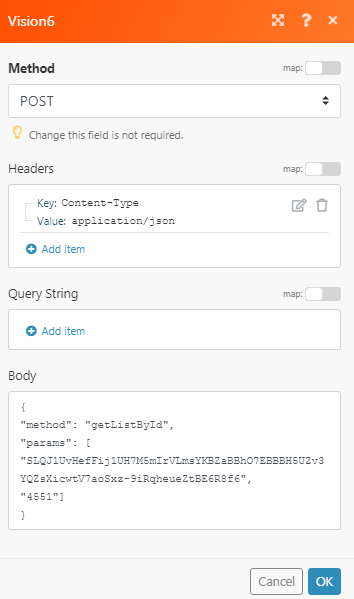
Matches of the search can be found in the module’s Output under BundleA bundle is a chunk of data and the basic unit for use with modules. A bundle consists of items, similar to how a bag may contain separate, individual items. More > Body.
In our example, the specified List ID details were returned:
